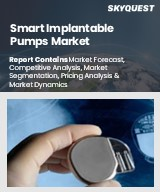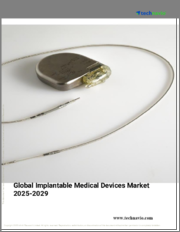
|
시장보고서
상품코드
1709507
세계의 이식형 포트 시장(-2035년) : 재료 유형, 용도, 삽입 방법, 지역별Global Implantable Port Market Research Report By Material Type, By Application, By Insertion Method and By Regional Forecast to 2035 |
||||||
이식형 포트 시장 규모는 2024년 32억 9,028만 달러에서 2025-2035년의 예측 기간 중 CAGR 6.21%로 성장할 것으로 예측됩니다.
만성질환 증가율 증가로 인해 장기적인 정맥 접근 수단에 대한 요구가 높아지면서 이식형 포트 시장이 활성화되고 있습니다. 의료진이 환자의 편안함과 치료 효과 향상에 초점을 맞추면서 이식형 포트의 인기는 점점 더 높아지고 있습니다. 또한 재택의료 및 외래진료의 확대에 따라 약물을 안전하고 효율적으로 투여할 수 있는 방법이 필요해지면서 수요가 더욱 증가하고 있습니다. 또한 의료 기술의 발전은 보다 견고하고 안전한 임플란트 구현을 보장하고 시장 성장을 가속하고 있습니다. 생체 적합성을 높이고 감염 위험을 감소시키는 재료의 개발은 보다 혁신적인 이식형 포트 설계의 길을 열어주는 기회가 되고 있습니다. 환자 중심 케어에 대한 관심이 높아지면서 원격 모니터링 시스템과 같은 디지털 헬스 기술을 활용하여 환자 관리를 강화할 수 있게 되었습니다. 특히 이러한 기술의 도입이 아직 초기 단계에 있는 개발도상국에서는 이식형 포트의 장점에 대한 의료진의 인식이 높아지면 시장 확대가 더욱 촉진될 것입니다. 최근 추세는 보다 덜 침습적인 시술로 전환하고 있으며, 이는 환자와 의료진 모두에게 이식형 포트의 매력을 높여주고 있습니다. 이러한 장비의 기능과 디자인을 개선하기 위해 제조업체와 의사가 점점 더 많이 협력하고 있습니다.
지역별 전망
2024년에서 최대 시장 점유율을 차지한 것은 북미이며, 2035년에는 24억 1,661만 달러에 달할 것으로 예측됩니다. 한편, 예측 기간 중 가장 높은 CAGR을 나타낸 것은 아시아태평양이어, 동기 마나카는 8.32%의 CAGR로 성장할 것으로 예측됩니다.
북미 시장은 2024년 13억 8,275만 달러에서 예측 기간 중 5.20%의 CAGR로 성장할 것으로 예측됩니다.
유럽 시장은 2024년 9억 7,235만 달러에서 예측 기간 중 6.41%의 CAGR로 성장할 것으로 예측됩니다.
세계의 이식형 포트 시장을 조사했으며, 시장의 정의와 개요, 시장 성장에 대한 각종 영향요인의 분석, 시장 규모 추이·예측, 각종 구분·지역/주요 국가별 내역, 경쟁 환경, 주요 기업의 개요 등을 정리하여 전해드립니다.
목차
제1장 개요
제2장 시장 개요
제3장 조사 방법
제4장 시장 역학
- 촉진요인
- 세계에서의 만성질환의 발생률 증가
- 기술의 진보
- 의료에 대한 액세스의 향상
- 억제요인
- 임플란트의 고비용
- 수술의 리스크
- 기회
- 신흥 시장으로의 진출
- 고령화 인구의 증가
제5장 시장 요인 분석
- 밸류체인 분석
- Porter's Five Forces 모델
- COVID-19가 세계의 이식형 포트 시장에 미치는 영향
제6장 세계의 이식형 포트 시장 : 재료별
- 개요
- 실리콘
- 폴리우레탄
- 티타늄
제7장 세계의 이식형 포트 시장 : 용도별
- 개요
- 화학요법
- 항생제 요법
- 완전 정맥 영양
- 수혈
제8장 세계의 이식형 포트 시장 : 최종사용자별
- 개요
- 병원
- 외래 수술 센터
- 전문 클리닉
제9장 세계의 이식형 포트 시장 : 삽입 방법별
- 개요
- 외과적 삽입
- 경피삽입
제10장 세계의 이식형 포트 시장 : 지역별
- 개요
- 북미
- 미국
- 캐나다
- 유럽
- 독일
- 프랑스
- 영국
- 이탈리아
- 스페인
- 러시아
- 기타
- 아시아태평양
- 중국
- 인도
- 일본
- 한국
- 말레이시아
- 태국
- 인도네시아
- 기타
- 남미
- 브라질
- 멕시코
- 아르헨티나
- 기타
- 중동 및 아프리카
- GCC 국가
- 남아프리카공화국
- 기타
제11장 경쟁 구도
- 기업 시장 점유율 분석
- 경쟁 대시보드
- 공개 기업의 주식 개요
- 비교 분석 : 주요 기업의 재무 동향
- 주요 개발·성장 전략
제12장 기업 개요
- ANGIODYNAMICS, INC.
- B. BRAUN MELSUNGEN AG
- BECTON, DICKINSON AND COMPANY(BD)
- COOK MEDICAL LLC
- DISTRICLASS MEDICAL SA
- VYGON
- SILMAG AG
- POLY MEDICURE LTD
- PAKUMEDMEDICAL PRODUCTS GMBH
- SOPHYSA
제13장 데이터 인용
KSA 25.05.13Global Implantable Port Market Research Report By Material Type (Silicone, Polyurethane, Titanium), By Application (Chemotherapy, Antibiotic Therapy, Total Parenteral Nutrition, Blood Transfusion), By Insertion Method (Surgical Insertion, Percutaneous Insertion) and By Regional (North America, Europe, South America, Asia Pacific, Middle East and Africa) Forecast to 2035
Overview of the Market
The size of the implantable port market was projected to be USD 3,290.28 million in 2024 based on MRFR analysis. The market for implantable ports is anticipated to develop at a compound annual growth rate (CAGR) of 6.21% between 2025 and 2035.
Growing rates of chronic illnesses are fueling the market for implantable ports by raising need for long-term intravenous access options. Implantable ports are becoming more and more popular as medical professionals concentrate on improving patient comfort and treatment efficacy. Demand is further increased by the expansion of home healthcare and outpatient settings, which need dependable and efficient ways to provide medication. Furthermore, improvements in medical technology guarantee stronger, safer implants, which propels market expansion. The creation of materials that enhance biocompatibility and reduce the risk of infection is one business opportunity that will open the door for more creative implantable port designs. Digital health technology, such remote monitoring systems, can be used to enhance patient management as the focus on patient-centric care grows. Increasing healthcare professionals' knowledge of implantable ports' advantages can further spur market expansion, particularly in poorer nations where adoption of these technologies is still in its infancy. Recent trends show a move toward less intrusive procedures, which increases the appeal of implantable ports for both patients and medical professionals. To enhance the functionality and design of these gadgets, manufacturers and physicians are increasingly working together.
Perspectives on Market Segments
The global market for implantable ports has been divided into three segments based on material type: silicone, titanium, and polyurethane.
The global implantable port market has been divided into four segments based on application: blood transfusion, chemotherapy, antibiotic therapy, and total parenteral nutrition.
The worldwide market for implantable ports has been divided into two segments based on the manner of insertion: percutaneous and surgical. The market segment with the quickest rate of growth over the forecast period is surgical insertion, which held the biggest market share in 2024.
Regional Perspectives
North America, Europe, Asia-Pacific, South America, and the Middle East & Africa are the regions into which the global implantable port market has been divided. The greatest market share in 2024 was held by North America, which is expected to grow to USD 2,416.61 million by 2035. Nonetheless, over the course of the forecast period, Asia-Pacific is anticipated to develop at the highest CAGR of 8.32%.
The implantable port market in North America was valued at USD 1,382.75 million in 2024 and is anticipated to expand at a compound annual growth rate (CAGR) of 5.20% over the course of the forecast period. The United States and Canada are two more divisions of North America.
The market for implanted ports in Europe was valued at USD 972.35 million in 2024 and is anticipated to expand at a compound annual growth rate (CAGR) of 6.41% over the course of the forecast period. Germany, France, the United Kingdom, Italy, Spain, Russia, and the rest of Europe are further divisions of Europe.
Key Players
Easton Medical, Baxter International, Zyga Technology, Terumo, Apex Medical Technologies, Medtronic, Boston Scientific, Cook Medical, AngioDynamics, Kirwan Surgical Products, Smiths Medical, Nitinol Devices Corporation, C R Bard, Stryker, and Halyard Health are some of the major players in the implantable port market.
TABLE OF CONTENTS
1 EXECUTIVE SUMMARY
- 1.1 OVERVIEW
- 1.2 MARKET ATTRACTIVENESS ANALYSIS
- 1.3 GLOBAL IMPLANTABLE PORT MARKET, BY MATERIAL TYPE
- 1.4 GLOBAL IMPLANTABLE PORT MARKET, BY APPLICATION
- 1.5 GLOBAL IMPLANTABLE PORT MARKET, BY END USER
- 1.6 GLOBAL IMPLANTABLE PORT MARKET, BY INSERTION METHOD
- 1.7 GLOBAL IMPLANTABLE PORT MARKET, BY REGION
2 MARKET INTRODUCTION
- 2.1 DEFINITION
- 2.2 SCOPE OF THE STUDY
- 2.3 RESEARCH OBJECTIVE
- 2.4 MARKET STRUCTURE
3 RESEARCH METHODOLOGY
- 3.1 OVERVIEW
- 3.2 DATA FLOW
- 3.2.1 Data Mining Process
- 3.3 PURCHASED DATABASE:
- 3.4 SECONDARY SOURCES:
- 3.4.1 Secondary Research Data Flow:
- 3.5 PRIMARY RESEARCH:
- 3.5.1 Primary Research Data Flow:
- 3.5.2 Primary Research: Number of Interviews conducted
- 3.5.3 Primary Research: Regional Coverage
- 3.6 APPROACHES FOR MARKET SIZE ESTIMATION:
- 3.6.1 Revenue Analysis Approach
- 3.7 DATA FORECASTING
- 3.7.1 Data forecasting Type
- 3.8 DATA MODELING
- 3.8.1 Microeconomic Factor Analysis:
- 3.8.2 Data modeling:
- 3.9 TEAMS AND ANALYST CONTRIBUTION
4 MARKET DYNAMICS
- 4.1 INTRODUCTION
- 4.2 DRIVERS
- 4.2.1 Increasing Incidences of Chronic Diseases across the globe
- 4.2.2 Technological Advancements
- 4.2.3 Better Healthcare Access
- 4.3 RESTRAINTS
- 4.3.1 High Cost of Implantation
- 4.3.2 Surgical Risks
- 4.4 OPPORTUNITY
- 4.4.1 Expansion in Emerging Markets
- 4.4.2 Growing Aging Population
5 MARKET FACTOR ANALYSIS
- 5.1 VALUE CHAIN ANALYSIS
- 5.1.1 R&D
- 5.1.2 Manufacturing
- 5.1.3 Marketing and Distribution & Channel
- 5.1.4 Post-market Surveillance
- 5.2 PORTER'S FIVE FORCES MODEL
- 5.2.1 Threat of New Entrants
- 5.2.2 Bargaining Power of Suppliers
- 5.2.3 Threat of Substitutes
- 5.2.4 Bargaining Power of Buyers
- 5.2.5 Intensity of Rivalry
- 5.3 IMPACT OF COVID-19 ON THE GLOBAL IMPLANTABLE PORT MARKET
6 GLOBAL IMPLANTABLE PORT MARKET, BY MATERIAL TYPE
- 6.1 OVERVIEW
- 6.2 SILICONE
- 6.3 POLYURETHANE
- 6.4 TITANIUM
7 GLOBAL IMPLANTABLE PORT MARKET, BY APPLICATION
- 7.1 OVERVIEW
- 7.2 CHEMOTHERAPY
- 7.3 ANTIBIOTIC THERAPY
- 7.4 TOTAL PARENTERAL NUTRITION
- 7.5 BLOOD TRANSFUSION
8 GLOBAL IMPLANTABLE PORT MARKET, BY END USER
- 8.1 OVERVIEW
- 8.2 HOSPITALS
- 8.3 AMBULATORY SURGICAL CENTERS
- 8.4 SPECIALIZED CLINICS
9 GLOBAL IMPLANTABLE PORT MARKET, BY INSERTION METHOD
- 9.1 OVERVIEW
- 9.2 SURGICAL INSERTION
- 9.3 PERCUTANEOUS INSERTION
10 GLOBAL IMPLANTABLE PORT MARKET, BY REGION
- 10.1 OVERVIEW
- 10.2 NORTH AMERICA
- 10.2.1 US
- 10.2.2 CANADA
- 10.3 EUROPE
- 10.3.1 GERMANY
- 10.3.2 FRANCE
- 10.3.3 UK
- 10.3.4 ITALY
- 10.3.5 SPAIN
- 10.3.6 RUSSIA
- 10.3.7 REST OF EUROPE
- 10.4 ASIA-PACIFIC
- 10.4.1 CHINA
- 10.4.2 INDIA
- 10.4.3 JAPAN
- 10.4.4 SOUTH KOREA
- 10.4.5 MALAYSIA
- 10.4.6 THAILAND
- 10.4.7 INDONESIA
- 10.4.8 REST OF ASIA-PACIFIC
- 10.5 SOUTH AMERICA
- 10.5.1 BRAZIL
- 10.5.2 MEXICO
- 10.5.3 ARGENTINA
- 10.5.4 REST OF SOUTH AMERICA
- 10.6 MIDDLE EAST AND AFRICA
- 10.6.1 GCC COUNTRIES
- 10.6.2 SOUTH AFRICA
- 10.6.3 REST OF MIDDLE EAST AND AFRICA
11 COMPETITIVE LANDSCAPE
- 11.1 INTRODUCTION
- 11.2 COMPANY MARKET SHARE ANALYSIS, 2024 (VALUE)
- 11.3 COMPETITOR DASHBOARD
- 11.4 PUBLIC PLAYERS STOCK SUMMARY
- 11.5 COMPARATIVE ANALYSIS: KEY PLAYERS FINANCIAL
- 11.6 KEY DEVELOPMENTS & GROWTH STRATEGIES
- 11.6.1 DONATION
- 11.6.2 AGREEMENT
12 COMPANY PROFILES
- 12.1 ANGIODYNAMICS, INC.
- 12.1.1 COMPANY OVERVIEW
- 12.1.2 FINANCIAL OVERVIEW
- 12.1.3 PRODUCTS/SOLUTIONS/SERVICES OFFERED
- 12.1.4 KEY DEVELOPMENTS
- 12.1.5 SWOT ANALYSIS
- 12.1.6 KEY STRATEGIES
- 12.2 B. BRAUN MELSUNGEN AG
- 12.2.1 COMPANY OVERVIEW
- 12.2.2 FINANCIAL OVERVIEW
- 12.2.3 PRODUCTS/SOLUTIONS/SERVICES OFFERED
- 12.2.4 KEY DEVELOPMENTS
- 12.2.5 SWOT ANALYSIS
- 12.2.6 KEY STRATEGIES
- 12.3 BECTON, DICKINSON AND COMPANY (BD)
- 12.3.1 COMPANY OVERVIEW
- 12.3.2 FINANCIAL OVERVIEW
- 12.3.3 PRODUCTS/SOLUTIONS/SERVICES OFFERED
- 12.3.4 KEY DEVELOPMENTS
- 12.3.5 SWOT ANALYSIS
- 12.3.6 KEY STRATEGIES
- 12.4 COOK MEDICAL LLC
- 12.4.1 COMPANY OVERVIEW
- 12.4.2 FINANCIAL OVERVIEW
- 12.4.3 PRODUCTS/SOLUTIONS/SERVICES OFFERED
- 12.4.4 KEY DEVELOPMENTS
- 12.4.5 SWOT ANALYSIS
- 12.4.6 KEY STRATEGIES
- 12.5 DISTRICLASS MEDICAL SA
- 12.5.1 COMPANY OVERVIEW
- 12.5.2 FINANCIAL OVERVIEW
- 12.5.3 PRODUCTS/SOLUTIONS/SERVICES OFFERED
- 12.5.4 KEY DEVELOPMENTS
- 12.5.5 SWOT ANALYSIS
- 12.5.6 KEY STRATEGIES
- 12.6 VYGON
- 12.6.1 COMPANY OVERVIEW
- 12.6.2 FINANCIAL OVERVIEW
- 12.6.3 PRODUCTS/SOLUTIONS/SERVICES OFFERED
- 12.6.4 KEY DEVELOPMENTS
- 12.6.5 SWOT ANALYSIS
- 12.6.6 KEY STRATEGIES
- 12.7 SILMAG AG
- 12.7.1 COMPANY OVERVIEW
- 12.7.2 FINANCIAL OVERVIEW
- 12.7.3 PRODUCTS/SOLUTIONS/SERVICES OFFERED
- 12.7.4 KEY DEVELOPMENTS
- 12.7.5 SWOT ANALYSIS
- 12.7.6 KEY STRATEGIES
- 12.8 POLY MEDICURE LTD
- 12.8.1 COMPANY OVERVIEW
- 12.8.2 FINANCIAL OVERVIEW
- 12.8.3 PRODUCTS/SOLUTIONS/SERVICES OFFERED
- 12.8.4 KEY DEVELOPMENTS
- 12.8.5 SWOT ANALYSIS
- 12.8.6 KEY STRATEGIES
- 12.9 PAKUMEDMEDICAL PRODUCTS GMBH
- 12.9.1 COMPANY OVERVIEW
- 12.9.2 FINANCIAL OVERVIEW
- 12.9.3 PRODUCTS/SOLUTIONS/SERVICES OFFERED
- 12.9.4 KEY DEVELOPMENTS
- 12.9.5 SWOT ANALYSIS
- 12.9.6 KEY STRATEGIES
- 12.10 SOPHYSA
- 12.10.1 COMPANY OVERVIEW
- 12.10.2 FINANCIAL OVERVIEW
- 12.10.3 PRODUCTS/SOLUTIONS/SERVICES OFFERED
- 12.10.4 KEY DEVELOPMENTS
- 12.10.5 SWOT ANALYSIS
- 12.10.6 KEY STRATEGIES



















